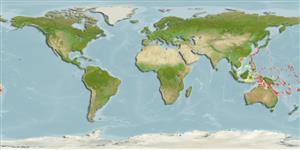Holothuroidea |
Holothuriida |
Holothuriidae
Environment: milieu / climate zone / εύρος βάθους / distribution range
Οικολογία
Υφαλόφιλο(α); εύρος βάθους 5 - 30 m (Αναφ. 122). Subtropical
Western Central Pacific: New Caledonia, Palau and Micronesia.
Length at first maturity / Μέγεθος / Weight / Age
Γεννητική Ωρίμανση: Lm ? range ? - ? cm Max length : 38.0 cm TL αρσενικό/απροσδιόριστο; (Αναφ. 122); common length : 27.0 cm TL αρσενικό/απροσδιόριστο; (Αναφ. 122); μεγ. δημοσιευμένο βάρος: 1.2 kg (Αναφ. 122)
Mean live weight 700 to 1,200 g; body thickness 0.5 cm. Body elongate, cylindrical, slightly arched dorsally (bivium) and flattened ventrally (trivium). Bivium generally covered by fine sediment. Papillae on bivium small, slender, and conical; cylindrical and thick podia on trivium arranged irregularly on the radii and interradii; calcareous disc of podia around 700 micrometer in diameter. Mouth ventral, surrounded by 20 stout tentacles. Anus sub dorsal, surrounded by 5 strong, triangular, and nodose anal teeth. Calcareous ring thick, with large radial pieces and narrow interradials. Cuvierian tubules absent. Bivium black; trivium dark brown. Spicules sparse in the ventral and dorsal tegument, abundant only near the mouth, anus, and tentacles; a few rods in the dorsal tegument give rise to numerous rosettes, rods, and various plates; small to large plates provided with holes and spines near the anus; tentacles with rods straight or arched, bearing small spines.
May be collected by divers for artisanal fisheries along with other "blackfish" species, but not intensively so, since it is found in comparatively low densities and has deeper distribution. Processed product is not distinguished from those of other Actinopyga species; probably has a moderate commercial value. Found in moderately shallow water; on the lagoon floor, sometimes burrowed in sandy-muddy sediments (Ref. 122). Also on sandy reef flats and protected fine sand lagoons and bays (Ref. 92930). Populations reach medium densities up to 0.1 per square meter. A poorly known species (Ref. 122).
Life cycle and mating behavior
Γεννητική Ωρίμανση | Αναπαραγωγή | Γεννοβολία | Eggs | Γονιμότητα | Larvae
Conand, C. 1998 Holothurians (sea cucumbers, Class Holothuroidea). p. 1157-1190. In Carpenter, K.E. and V.H. Niem (eds.) FAO Species Identification Guide for Fishery Purposes. The Living Marine Resources of the Western Central Pacific. Vol. 2. Cephalopods, crustaceans, holothurians and sharks. FAO Rome. (Αναφ. 122)
IUCN Red List Status
(Αναφ. 130435: Version 2025-1)
CITES status (Αναφ. 108899)
Not Evaluated
Not Evaluated
Threat to humans
Harmless
Human uses
αλιεία: Εμπορικό(ά)
| FishSource |
Εργαλεία
Περισσότερες πληροφορίες
Τροφική ΟικολογίαFood items (preys)
Σύσταση δίαιτας
Κατανάλωση τροφής
Θηρευτές
Population dynamicsΑύξησηMax. ages / sizesLength-weight rel.Length-length rel.Length-frequenciesMass conversionΑφθονία Life cycleΑναπαραγωγή
Γεννητική Ωρίμανση
Γονιμότητα
Γεννοβολία
Eggs
Egg development
Larvae
PhysiologyΚατανάλωση οξυγόνου
Human RelatedStamps, coins, misc.
Διαδικτυακές πηγές
Estimates based on models
Preferred temperature
(Ref.
115969): 24.7 - 29.4, mean 28.3 (based on 1018 cells).
Fishing Vulnerability
Low to moderate vulnerability (28 of 100).
Price category
Unknown.
